Thigh Length and Seat Angles
 Mon, June 28, 2021
Mon, June 28, 2021 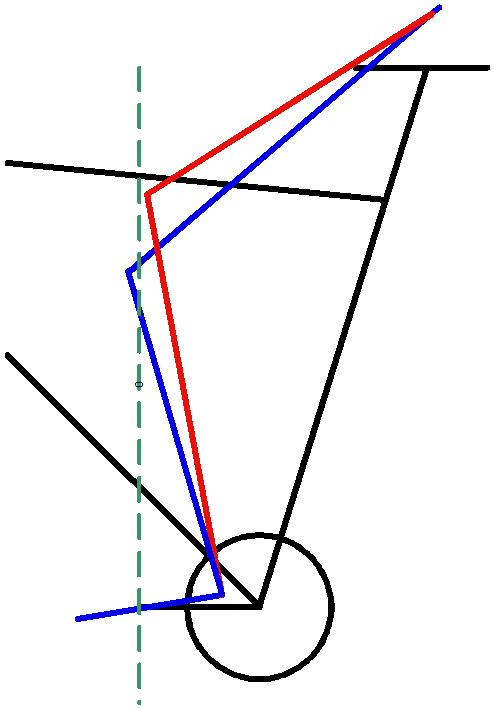
I am often asked if a rider with a long thigh measurement needs a shallower seat angle. The above line drawing represents two riders with the same inside leg measurement. As a result, they have their saddle set at the same height, and they are using the same size frame.
If the inside leg measurement is the same and one has a longer thigh measurement from his hip to his knee, it follows his lower leg from his knee to his heel is shorter. Conversely, short thigh, longer lower leg. As you can see from the sketch the position of the knee varies only slightly.
The exact knee over pedal (KOP) is not a precise measurement anyway as one is pedaling in circles, and it makes little difference if the rider sits back and pushes forward or is more over the pedals pushing straight down.
For the purpose of this drawing, I made the thigh length of the blue leg the same as the lower leg of the one represented by the red line, and vise-versa. The above line drawing could represent an unlimited number of riders with the same inside leg, with the red and blue lines being the extremes. If the inside leg measurement is a constant, it follows that as the one measurement increases the other decreases.
This simple drawing does not consider the length of foot. {Shoe size.) As the toe points down at the bottom of the pedal stroke, the foot becomes an extension of the leg. This of course affects saddle height and frame size but does not change the position of the knee by any large amount.
So, the answer is no. Once you have the correct size frame the seat angle should be right for that size frame. Then if your saddle is positioned at the correct height, the length of your thigh has little bearing on anything.
Also, as a footnote, some people agonize over the fore and aft position of their saddle. If you view that too considering what I have said here, it is less important. More important is the position of the handlebars in relation to the saddle. See the links below for more info on that.
You can read more about my frame design philosophy here:
And another article on Riding Position Simplified:


















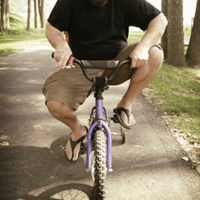
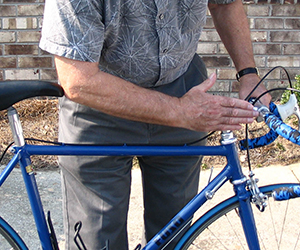

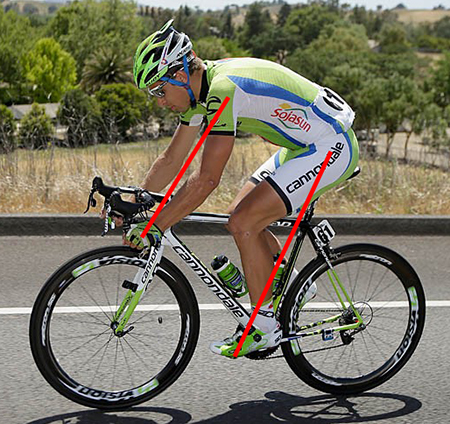
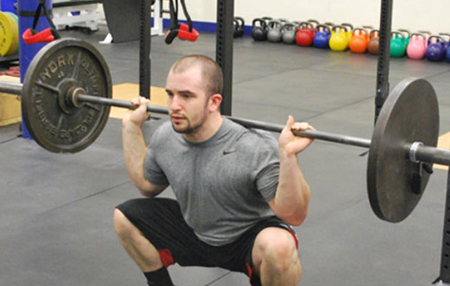

Crank Length
There is a reason I haven’t touched on this subject before in over eleven years writing here. It is one of those subjects like "Knee over Pedal." I feel it is unimportant and irrelevant.
However, when I started to think about it, I realized I could maybe throw some logic on the fire, rather than adding to the huge pile of horse shit that is already out there. The whole reason to mess with anything like crank length is to improve performance. Go faster for the same amount of effort.
Were it that simple someone would have figured it out long before now and we would all be using something different than we have been using for the last 100 years. And if ever there was a case for the old adage, “If it ain’t broke, don’t fix it,” this is it.
The part that most fail to grasp is that increasing crank length increases leverage, meaning (In theory.) you can push a bigger gear, but unless you can pedal this higher gear at the same RPM for the same amount of effort, you are not going any faster.
Your feet, and the leg muscles that drive the feet, are having to move a greater distance (Therefore greater speed.) per revolution of the crank. You may as well stick with the standard length crank and pedal the lower gear. You are traveling at the same road speed, relative to the speed your feet and legs are moving.
Also if you are switching from a 170 to a 175mm. crank, that is one centimeter greater pedaling circle. Your saddle needs to stay in the same place. (Let’s assume for this argument that your saddle height was right to start with.) If you lower the saddle by 5mm. your knees will be coming up a full centimeter higher at the top of the stroke.
Better to leave the saddle where it is. Your crank and pedals will still be at the center of the turning circle you are used to. The extra length of the crank will be equally spread 5mm. extra reach at the bottom of the stroke, and 5mm. higher at the top of the stroke.
I notice longer cranks are being touted as a cure for various leg pains. Often leg and other pains are because the rider is not in the peak of physical condition. Start any exercise regimen, not just cycling, and the participant will often feel discomfort. All one can do is slowly and carefully work through it, until the body becomes accustomed to the extra stress being placed on it.
I fail to see where pedaling in a larger circle can help. It is placing more stress on the body, not less. It is akin to telling your doctor that walking is painful, and he suggests you walk faster and take longer strides. Just because long legs can accommodate longer cranks, doesn’t mean they should, or that there is necessarily an advantage in doing so. Try adjusting your saddle height first. It costs nothing and it is less of a shock on your system.
Here is another analogy. A person with long legs could climb stairs two steps at a time. He may get to the top of the building quicker, but one thing for sure, he has expended a lot more energy in doing so. Just because he can climb stairs two at a time, doesn’t mean he should.
Of course there is nothing stopping him climbing stairs two at a time, and there is nothing stopping him from fitting different length cranks, I am just pointing out that anyone saying there is some big advantage in doing so, is simply blowing smoke.
The big wheel was around 60 inches or five feet diameter, cranks had to be short in order to keep the wheel diameter as large as possible.
When the chain driven bike came on the scene in 1885, there were no restrictions on crank length. However, its invention was soon followed by mass production of bicycles and standards had to be set. It was England that started the bike industry and so set the early standards. Even today the world uses half inch pitch bicycle chain as standard when the most of the world uses metric measure for almost everything else.
The standard crank length was soon established at 6 1/2 inches for most bicycles. Because twice 6 1/2 is 13 inches, which is an average stride length for a leisurely walk. However, later it was found for racing bikes 6 3/4 worked better. 7 inches was too long for all but the tallest riders. That 1/4 inch either way made a big difference.
Do you ever wonder why Campagnolo offer a 172.5 mm. crank? Up until WWII Britain led the world in bicycles and components, including the high end racing equipment. 6 3/4 inch cranks were the standard for racing worldwide.
After WWII, Italy really moved into the component market. 172.5 mm. is pretty close to 6 3/4 inches. So this became the new standard. It did in the UK anyway. Everyone I knew, myself included, used 172.5, a few taller guys used 175. It is interesting that Campagnolo is the oldest established out of the big three companies. Campagnolo, Shimano, and Scram, and they still only offer 170. 172.5, and 175mm. crank lengths. Maybe it is all we need.
There may be a case for 180 cranks for someone with exceptionally long legs, say 36 inch or longer. Conversely, 165 cranks for a person with 29 or less inseam. But this whole range of crank lengths throughout the complete range of body sizes I feel is just hype put out there by the bike fitting industry.
Many of the best bike riders in the world range in height roughly between 5’ 7” and 5’ 11.” They ride small to mid-size bikes, and use standard length cranks. It has always been that way for years. Of course there are exceptions, but he day tall, long legged guys using long cranks, start dominating professional racing, is the day I will change my views on crank length.
Certain things in bicycle design were established many years ago, and remain the same because it happens to be right. Half inch pitch chain, already mentioned. 27 in. wheel diameter. (Measure your 700c tire.) 73 degrees is the best head angle for a road bike. The same with crank lengths.
The original crank lengths set over 100 years ago were: 6 1/2 inches (Almost exactly 165mm.) 6 3/4 inches, which is right in between 170 and 175mm. And 7 inches (Slightly less than 180mm.) That is all the range you need. It works, why fuck with it?
To sum up, yes there is a case for different crank lengths, but only over the relatively small range of a centimeter and a half. 165mm. to 180mm. This should accommodate the extreme range of leg lengths well beyond normal averages. Campagnolo's range, 170, 172.5, and 175 is fine for most of us.
Remember too, I don't have a pig in this market, I’m not trying to sell you anything. My final advice, just enjoy the bike, and stop trying to over-think it.